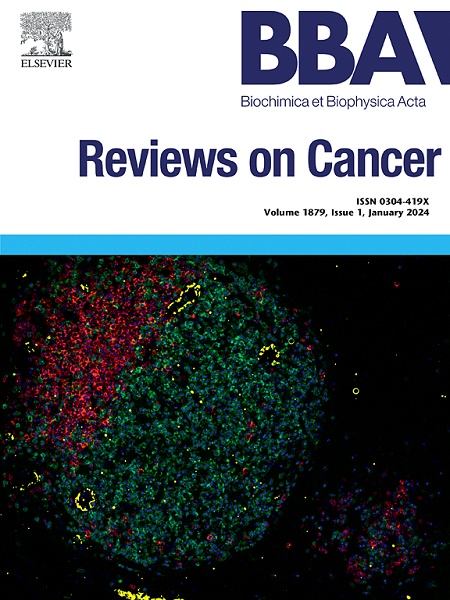鼻咽癌中的程序性细胞死亡:机制与治疗目标。
IF 9.7
1区 医学
Q1 BIOCHEMISTRY & MOLECULAR BIOLOGY
Biochimica et biophysica acta. Reviews on cancer
Pub Date : 2025-02-01
DOI:10.1016/j.bbcan.2025.189265
引用次数: 0
摘要
程序性细胞死亡是一种由维持体内平衡和生长的基因控制的自主有序的细胞死亡模式。肿瘤是人体内环境稳态失衡的典型表现。目前,几种肿瘤治疗被设计为触发肿瘤细胞死亡。鼻咽癌是中国最常见的恶性肿瘤之一。发病率有明显的地区和民族差异,呈现出南方高、北方低的特点。鼻咽癌目前被认为是一种多基因遗传性疾病,通常由多基因之间或基因与环境之间的相互作用介导。细胞凋亡一直被认为是肿瘤治疗的关键,而其他细胞死亡途径往往被忽视。本研究综述了细胞凋亡、自噬、焦亡、坏死、铁亡与鼻咽癌之间的关系,并从分子角度合成了基于五种细胞死亡模式的鼻咽癌调控途径。我们希望这篇综述将有助于探索更多新的治疗鼻咽癌的程序性细胞死亡靶点,从而促进深入研究。本文章由计算机程序翻译,如有差异,请以英文原文为准。

Programmed cell death in nasopharyngeal carcinoma: Mechanisms and therapeutic targets
Programmed cell death is a type of autonomic and orderly cell death mode controlled by genes that maintain homeostasis and growth. Tumor is a typical manifestation of an imbalance in environmental homeostasis in the human body. Currently, several tumor treatments are designed to trigger the death of tumor cells. Nasopharyngeal carcinoma is one of the most common malignant tumors in China. It displays obvious regional and ethnic differences in its incidence, being typically high in the south and low in the north of China. Nasopharyngeal carcinoma is currently considered to be a polygenic inherited disease and is often mediated by the interaction between multiple genes or between genes and the environment. Apoptosis has long been considered the key to tumor treatment, while other cell death pathways have often been overlooked. The current study provides an overview of the relationship among apoptosis, autophagy, pyroptosis, necroptosis, ferroptosis, and nasopharyngeal carcinoma, and the regulatory pathways of nasopharyngeal carcinoma based on five cell death modes were synthesized from the view of molecule. We hope this review will help explore additional, novel programmed cell death targets for the treatment of nasopharyngeal carcinoma and thus promote in-depth research.
求助全文
通过发布文献求助,成功后即可免费获取论文全文。
去求助
来源期刊

Biochimica et biophysica acta. Reviews on cancer
医学-生化与分子生物学
CiteScore
17.20
自引率
0.00%
发文量
138
审稿时长
33 days
期刊介绍:
Biochimica et Biophysica Acta (BBA) - Reviews on Cancer encompasses the entirety of cancer biology and biochemistry, emphasizing oncogenes and tumor suppressor genes, growth-related cell cycle control signaling, carcinogenesis mechanisms, cell transformation, immunologic control mechanisms, genetics of human (mammalian) cancer, control of cell proliferation, genetic and molecular control of organismic development, rational anti-tumor drug design. It publishes mini-reviews and full reviews.
 求助内容:
求助内容: 应助结果提醒方式:
应助结果提醒方式:


